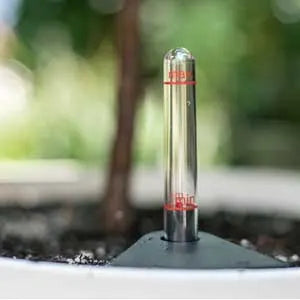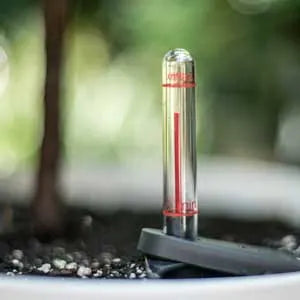Pencil Cactus Care
Placement
PRO TIP: When in doubt, let it drought! If the soil feels slightly moist and you are unsure whether or not to water, the safest bet is to wait and check back in a few days.
The Pencil Cactus (Euphorbia tirucalli) — also commonly called milk bush due to its thick, white sap — is native to semi-arid tropical regions of Africa and India. In the wild, the Pencil Cactus can grow up to 30 feet tall and well over 6 feet indoors. This stem succulent is not a true cactus and photosynthesizes in its stems, not through the small leaves that appear at the end of its new growth (which are inconsequential to the plant’s health).
As these plants evolved in dry climates with lots of sun, keep your Pencil Cactus in a bright location for maximum growth. This plant will not tolerate low light conditions. Direct sun, or plenty of bright ambient light from a western, eastern, or southern facing window is ideal for this plant to thrive.
If you are unsure of whether the light in your home or office is bright enough to support a Pencil Cactus, we have a guide for how to measure light in your space.

The thick, white sap the Pencil Cactus oozes when cut or snapped is a poisonous latex, but has been used in traditional medicine by many cultures to cure cancer, excrescence, tumors, and warts.
Routine Maintenance
PRO TIP: Keep your cactus away from cool drafts and air vents. Although very hardy, the Pencil Cactus prefers dry, warm environments.
Always be sure to assess your plant’s watering needs upon receiving it. Before giving your plant a drink, it is best to check the moisture level in the soil first to ensure it isn’t moist right beneath the surface. Also, consider aerating the soil of your plant before the initial watering. We compact the soil to avoid shifting during transit, so aerating can help the soil breathe and allow moisture to be released.
Pencil Cacti like to dry out completely between waterings. The most common mistake made with these plants is overwatering. You won’t need to water your plant more than once every 10 days (at most) during the growing season. During the winter months, watering frequency should decrease, sometimes to as little as once a month. Make sure that you are letting the soil thoroughly dry between waterings. Pencil Cacti are susceptible to root rot, so it’s very important that you do not water the plant if you detect any moisture in the soil.
Use caution when handling Euphorbia plants. Though the Pencil Cactus is a simple and easy plant from which to take cuttings and propagate, the milky sap can cause moderate to severe allergic reactions, especially in those with latex sensitivities. Take care when handling your Pencil Cactus, wear gloves if possible, and be sure to wash your hands thoroughly afterward.
Rotate your plant periodically to ensure even growth on all sides and dust the stalks often so the plant can photosynthesize efficiently. When dusting the leaves, also take the opportunity to inspect the undersides and keep an eye out for pests.
Remember each plant is a unique living thing and may have varying needs, especially in their individual locations. Pay attention to the condition of your Pencil Cactus and its watering needs and you will have a long and happy relationship.
Standard Planter Instructions

There are two types of standard planters offered by Greenery NYC—those with drainage holes, and those without. Within those two categories are an array of sizes and styles to choose from. The presence of drainage holes and size of the vessel play a role in the quantity and frequency of water given to your plant.
Plants purchased in a pot without a drainage hole have been set up with a built-in drainage system. A layer of hydro stones (porous, absorbent material made of recycled glass) has been placed beneath the soil to act as a reservoir for any excess water that flows through the soil. You will need to be slightly more cautious not to pour too much water into these containers as there is no way for the excess water to escape. We suggest pouring small amounts of water in bit by bit, until you have reached the desired moisture level in the soil.
For plants potted with drainage, water until it begins to come out the bottom of the pot and into the catch tray.
Always be sure to assess your plant's watering needs upon receiving it. Refer to the routine maintenance section for your plant’s specific moisture requirements.
Self Watering Container Instructions

The self-watering planters require a good, solid watering of the topsoil after they are first placed. This is important because the roots of the plants need to grow into the reservoir first in order to drink from it. Follow the standard planter instructions for the first four weeks. Then the reservoir is ready to be tested.
TEST: After four weeks, fill the water reservoir until the red indicator reaches the MAX line. If the indicator goes down over the first few days, it means the plant is ready for regular reservoir servicing. If not, be sure to continue top watering for a few more weeks, until the red indicator goes down, meaning the plant has started drinking from the reservoir.
RESERVOIR SERVICING: Once the indicator goes down, do not refill the reservoir right away. Similar to how humans need a breath of air between gulps of water, almost all plants require a drying out period. Always allow for the reservoir to empty all the way, and after a drying out period of a few days, be sure to refill it until the indicator reaches the MAX line.
From here on out, you should NEVER topwater the plant. If you water from the top, it can drown the plant. In the Self Watering Container, the top layer of soil will eventually become extremely dry and hard, and may even pull away from the edges of the pot. This is not a cause for concern, but simply because the plant is drinking directly from its roots in the water reservoir.

Step 1: Top water for two weeks. The indicator will look empty, like the picture above.

Step 2: Fill the reservoir until the red indicator reaches the MAX line.

Step 3: Watch the indicator over the next day or two. If it goes down on its own, it means the roots of the plant have grown into the reservoir. From here on out, ONLY water in the reservoir.
Frequently Asked Questions
Is it possible to underwater my Pencil Cactus?
- It is! Signs of underwatering are typically brown crispy tips and wrinkly flesh. The difference between symptoms of over and underwatering can be hard to discern, so it’s always best to feel the soil to test if the moisture matches with your diagnosis.
How can I tell if my Pencil Cactus is getting too much water?
- Generally a Pencil Cactus will become less stable, droopy, and turn greyish brown if it is receiving too much water. Pieces of the plant may turn grey and fall and although they look brittle, this symptom is often from overwatering. Feel the soil of your plant and test the moisture to see if it matches your diagnosis.
How often should I fertilize my plant?
- In general, house plants will thrive when they are fertilized spring through fall. Fertilize once a month with an organic houseplant fertilizer, following the package instructions for dilution and administration. Greenery NYC uses an organic potting mix with a slow release fertilizer in the soil, so your plant will not need fertilizer within the first 6 months of receiving it.
How often does my plant need to be repotted?
- We suggest repotting every 2 - 3 years. Cacti are slow growing, and they prefer to be somewhat pot bound so you can wait longer than you would with most houseplants. Be sure to choose a potting vessel 2”- 4” larger in diameter to allow for growth. Don’t choose a pot much larger than this as this could drown the plants roots. If you prefer to maintain the current size of your plant, repot into the same vessel, providing new soil and trimming away some roots and foliage. Spring or summer is the ideal time to repot as the plant is at its strongest.
Additional Care Guides
email signup
Get the first look at new products, collaborations, events, sales and more


